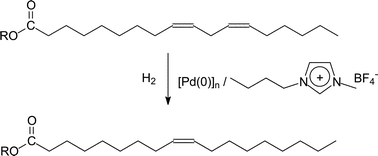An important drawback to be overcome in biodiesel technology is its low oxidative stability. One approach to improve the oxidative stability of soybean oil biodiesel is the partial hydrogenation of double bonds. In the current work, an efficient two-phase catalytic system using palladium acetate dissolved in BMI·BF4 ionic liquid to an in situ generation of palladium nanoparticles was developed in order to promote a selective hydrogenation reaction. Upon using this catalytic system it was possible to partially hydrogenate biodiesel into mono-hydrogenated compounds avoiding the formation of saturated compounds. The nanoparticulate system was compared with the traditional heterogeneous Pd/C system and gave far higher selectivity. It was possible to recover and reuse the ionic phase containing the catalyst up to three times without significant loss in its catalytic performance. Indeed, atomic absorption spectroscopy showed an excellent reclaim of the catalyst, which stayed in the ionic phase. Several parameters, such as temperature, hydrogen pressure, metal concentration and reaction time, were also evaluated.

You have access to this article
 Please wait while we load your content...
Something went wrong. Try again?
Please wait while we load your content...
Something went wrong. Try again?


 Please wait while we load your content...
Please wait while we load your content...